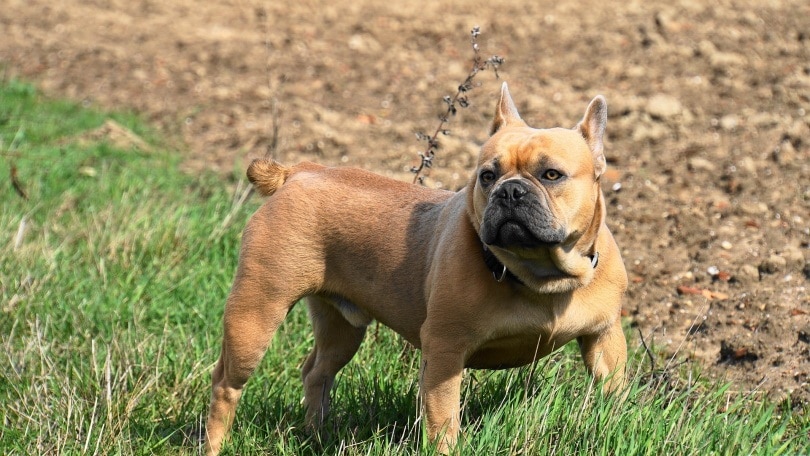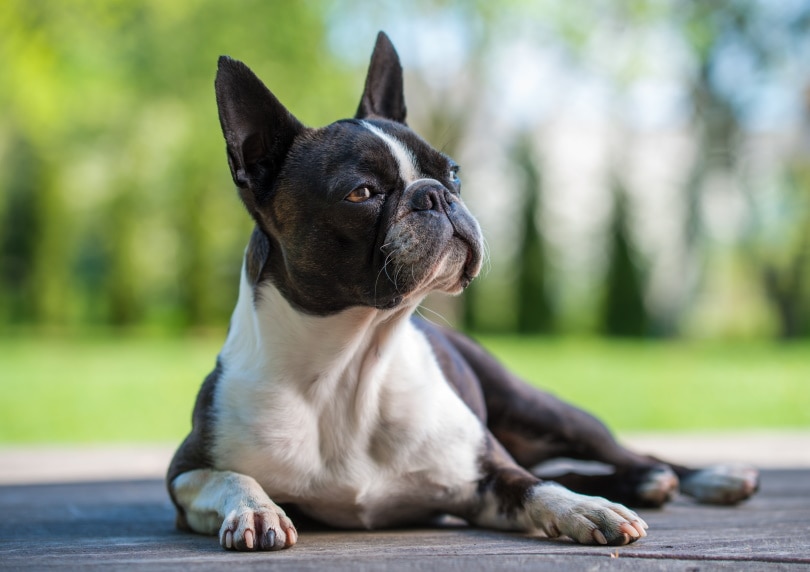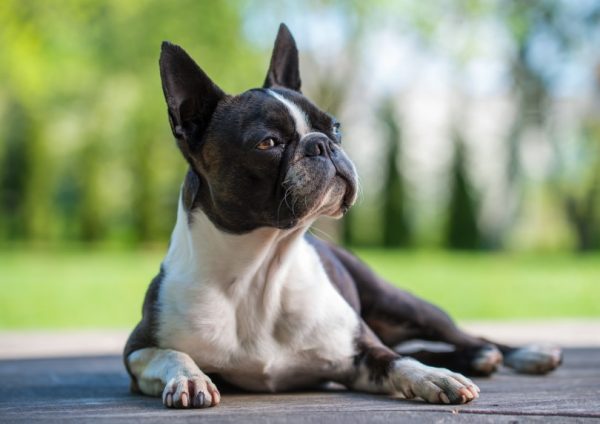Click to Skip Ahead

19th Century
The creation of the Boston Terrier began in Southborough, Massachusetts. Joseph Burnett, a chemist who manufactured vanilla extract, lived in the town in a large mansion. His son, Edward Burnett, owned an all-white Bulldog named Burnett’s Gyp. In the late 1860s, Burnett’s Gyp was mated with an English Bulldog and White English Terrier mix named Hooper’s Judge. The couple only produced one puppy named Well’s Eph. Well’s Eph had white markings and a dark brindle coat. Eventually, the dog was mated with a female named Tobin’s Kate with a golden brindle coat. The couple’s offspring are the ancestors of the true Boston Terriers we know today.
In the late 19th century, the Industrial Revolution helped elevate the social standing of ordinary citizens. This upward mobility allowed the middle-class residents of the United States to afford dogs as pets, and soon, the French Bulldog, Bull Terrier, and Boston Terrier became sought-after breeds. Each dog had its origins in dogfighting, but breeders focused on preserving the round face of the Bulldog and the compact Terrier body. Unlike the Bull Terrier that was considered the gentleman’s companion in England, the Boston Terrier was bred to be smaller and appeal to women.
Because of its curved skull and massive eyes, the Boston Terrier was initially named the “roundhead.” Some breeders also wanted to call it the American Bull Terrier, but Bull Terrier fanciers objected, and the dog was named the Boston Terrier after its birthplace.
In 1891, the Boston Terrier Club of America was established, and breeders tried to convince the American Kennel Club (AKC) that the Boston Terrier was worthy of show dog status. The AKC made history in 1893 when it officially recognized the Boston Terrier as an established breed.
The Boston Terrier became a favorite of middle and upper-class households in the last years of the 19th century, and the dogs soon became more popular than the pug or toy spaniel. However, the late 19th century Bostons were much different from today’s breed. Breeders could not agree on standards for the dog’s colors, body shape, or size. In the early 20th century, the dog’s appearance became more standardized.

20th Century
Boston Terrier breeders had used the French Bulldog as part of their breeding stock, but they wanted to differentiate the ear shape and colors of the Bostons from the bulldogs. French Bulldogs have rounded ears, but the breeders separated that trait so that Bostons would have pointed ears. Boston fanciers and breeders eventually agreed on a standard set of colors, markings, and body shapes. Solid black, seal and the brindle pattern became the coat colors, and other traits like banded muzzles and white areas on the collar and legs became elements of the standard.
Boston Terriers gained the nickname the “American Gentlemen” because of their tuxedo coat patterns, and after 1910, the dogs became the most popular canines in the United States. Advertisers used the dog to promote playing cards and tobacco products, and in 1914, the AKC published revised standards for the breed. Small Boston Terriers sold quicker than the larger dogs weighing close to 35 pounds, but the standard weight shrank down to 25 pounds through inbreeding and line-breeding.
Between 1900–1950, AKC registered more Bostons than any other breed in the United States. The dog’s popularity exploded in the early 20th century, and Boston University decided to make the dog its official mascot in 1922. The author Helen Keller and jazz musician Louis Armstrong were both given Boston Terriers as gifts and became fans of the breed.
Although the dog’s popularity waned during the Great Depression, it remained one of the top breeds towards the end of the century. In 1979, the Boston Terrier was named the state dog of Massachusetts.

Present Day
The Boston Terrier continues to steal the hearts of dog lovers around the world. In 2023, the AKC published its most popular dogs in America list, and the Boston Terrier ranked 23rd. Pet parents are drawn to the dog because of its infectiously friendly personality and large “puppy dog” eyes. Breeders continue to carry on the standards set in the early 20th century, but some have ventured into crossbreeding the Bostons with other dogs.
- Bodach: Boston Terrier and Dachshund
- Bojack: Boston Terrier and Jack Russel Terrier
- Boglen Terrier: Boston Terrier and Beagle
- Bosapso: Boston Terrier and Lhasa Apso
- Boshih: Boston Terrier and Shih Tzu
- Bossi-Poo: Boston Terrier and Poodle
- Bostaffy: Boston Terrier and Staffordshire Bull Terrier
- Bostchon: Boston Terrier and Bichon Frise
- Bostillon: Boston Terrier and Papillon
- Bostinese: Boston Terrier and Pekingese
- Boston bulldog: Boston Terrier and English Bulldog
- Boston lab: Boston Terrier and Labrador Retriever
- Boston Spaniel: Boston Terrier and Cocker Spaniel
- Boxton: Boston Terrier and Boxer
- Brusston: Boston Terrier and Brussels Griffon
- Bugg: Boston Terrier and Pug
- Cairoston: Boston Terrier and Cairn Terrier
- Chibo: Boston Terrier and Chihuahua
- Frenchton: Boston Terrier and French Bulldog
- Hava-Boston: Boston Terrier and Havanese
- Miniature Boston pinscher: Boston Terrier and Miniature Pinscher
- Pomston: Boston Terrier and Pomeranian
- Sharbo: Boston Terrier and Chinese Shar-Pei
Final Thoughts
Although its ancestors were used to catching vermin and fighting to the death, the Boston Terrier has evolved into a faithful companion and infinite source of joy and entertainment. Although breeds like the American Foxhound were bred in the United States in the early 18th century, the Boston Terrier was the first U.S. breed recognized by the AKC. Most canines took several decades to gain acceptance and recognition by the AKC, but the Boston Terrier’s path only took 18 years (1875–1893).
Related Reads:
- What Were Shih Tzus Bred For? History of the Shih Tzu
- What Were Mastiffs Bred For? History of the Mastiff
- What Were Schnauzers Bred for? History of the Schnauzer
- National Boston Terrier Day: When It Is & How It’s Celebrated
Featured Image Credit: bubutu, Shutterstock











